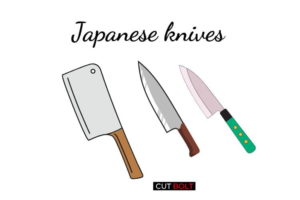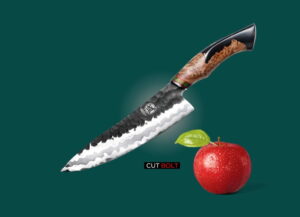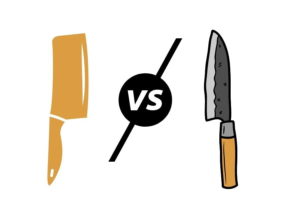Chef Gordon Ramsay has been described as “the world’s greatest living chef,” but it’s not just because he can throw a mean pasta, grill a steak to perfection or make a delicious risotto. It’s because he has a keen understanding of how to use a chef’s knife—and it shows in his works.
This is a quick and easy guide on how to use a chef knife. We also give tips on how to choose a chef’s knife and learn how to properly cut through meats, vegetables and bread.
Here is the list of things we have about using a chef’s knife:
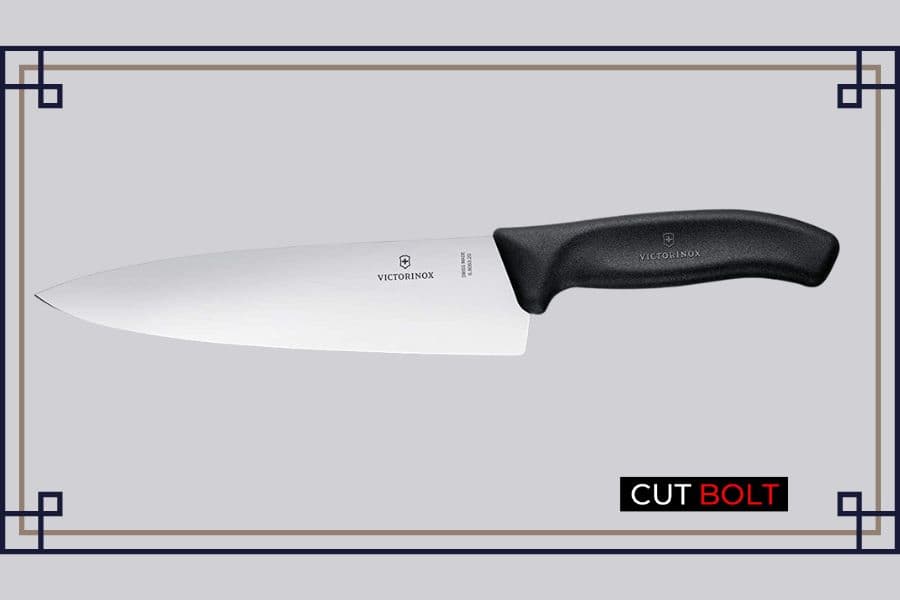
WHAT IS A CHEF KNIFE AND WHAT IS IT USED FOR?
If you want to be a master chef, it’s important to learn how to properly use the Western-style chef’s knife. It’s the most common type of chef’s knife, but it’s not the only type of chef’s knife.
A chef’s knife is typically around 8 to 12 inches long when measured from the heel to the tip of the blade, and is most often used to slice and chop ingredients for cooking and creating dishes.
The chef’s knife is the most versatile knife in the kitchen. It slices and chops fruit and vegetables, minces herbs, cuts through large slabs of meat and bone, and can even be used to carve a turkey. The belly of the chef’s knife supports rocking motion and the tip helps for finer work. The tough rinds of winter squashes and melons can be handled by the heavy-duty heel.
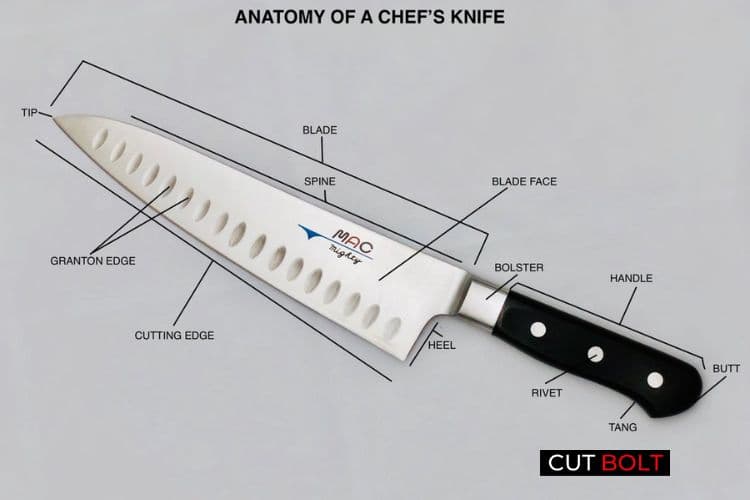
DIFFERENT PARTS OF A CHEF KNIFE
A good chef knife should have a sharp blade, a comfortable handle, and a straight spine. From the tang to the tip, we’ll explain the different parts, how to use them, and how to select the right chef knife.
Tang: A knife has two main parts – the tang and the handle. There are knives with full-tangs (a blade that extends the entire length of the handle), and partial tangs (where the tang only extends partway down the handle). In general, a knife with a full tang offers better balance, better performance, and a longer lifespan than one with a partial tang.
Handle: If you want to get a better understanding of knife handles, look for one that fits comfortably in your hand. Because the handle is as important as the blade. The handle is the part that you hold inside your hand. So, it should be made of good material and ergonomic to support a longer or shorter time of use.
Rivet: A rivet is a metal screw used to connect the tang to the handle of the knife. When looking at a rivet, always check for smoothness and a flat surface against the handle of the knife.
Bolster: If your knife has bolsters, it is probably a good-quality knife, since the bolster helps keep your fingers from slipping. Bolsters are located at the top of the handle opposite the cutting edge.
Heel: The heel is where the handle meets the exposed part of the blade. It’s the strongest part of the knife, so the heel is ideal for chopping hard things like nuts, carrots, or bones.
Edge: The edge of a knife is the most important part (it cuts ingredients). If the edge is not sharp enough to cut through the vegetables, fish, or meat you’re cutting, you’ll be wasting your time. Look for a blade with a sharp edge and made from premium quality steel like Japanese steel, Damascus steel or German steel.
Spine: Spine is the opposite side of the cutting edge. There are three main types of spines: the bevel, straight, and the concave. Each spine type has its own advantages and disadvantages, so it’s up to you to decide which spine type is best for your particular knife.
Blade: This is the entire knife if we leave the handle aside. A blade should be made from good steel that stays sharp, sturdy and durable.
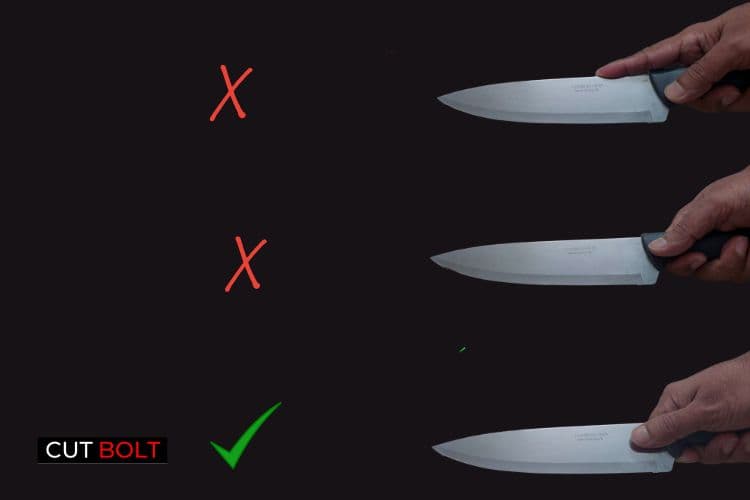
HOW TO USE A CHEF KNIFE
To learn how to properly use this multi-purpose cutting tool, you need to practice holding it correctly. It also helps if you know how to hold a knife, whether you are right-handed or left-handed, in order to avoid injuries.
HOW TO HOLD A KNIFE PROPERLY
You’ll find the “bolster” on your chef knife by feeling for a little protrusion near the heel of your knife. Place your right or left index finger underneath the “bolster” to properly hold the chef knife.
The index finger and thumb should be on opposite ends of the handle, pinching the blade, which is referred to as the pinch grip. Your other three fingers should be loosely wrapped around the end of the handle.
The knife should be held at a 45-degree angle to the table, and you should be able to move the blade away from your body when cutting.
HOW TO CUT WITH A CHEF KNIFE
After you’ve mastered how to properly grip your knife, it’s time to lear some cutting techniques. Use your guiding hand – one you use to hold the ingredients in the proper position.
The knife should glide gently up and down the knuckle on your index finger while you carefully curl your other three fingers under and around the food to be cut. This is called the claw grip.
If you keep the knife perpendicular to the cutting board and don’t press down with the heel of your hand, you’ll have better control. This is especially helpful when you’re chopping larger items like onions and garlic.
While this technique is not comfortable for everyone, if you want to get more precise control over the knife you can wrap your fingers all the way around its handle. Experiment with the different grips to see what works for you. Your knife handle, as well as your hand size and the shape of the handle can influence the way that you hold your knife.
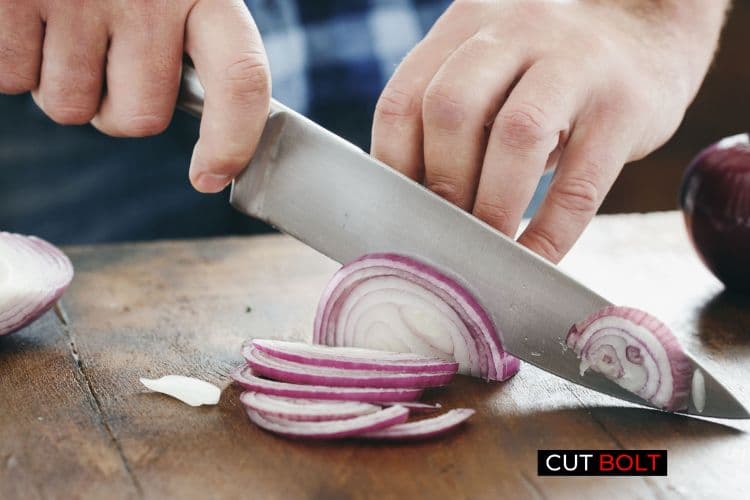
HOW TO SLICE WITH A CHEF KNIFE
For best results, first slice an onion vertically into halves. Place an onion half in the center of the cutting board and hold down both sides of the onion with the palms of your hands. With a sharp knife, slice downward toward the onion and release as soon as the vegetable is sliced all the way through.
The tip of your knife should be against the board to create slices. Pull the knife back toward the food until it just begins to slice. You can use a rocking motion to push the knife down and forward. The entire motion of the knife is almost circular, and the tip should not leave the board.
Follow the same process for other food ingredients like potato or tomato. The key point is to make the ingredients stable on the cutting board. You can cut off the top or bottom side first so it stays flat on the chopping board.
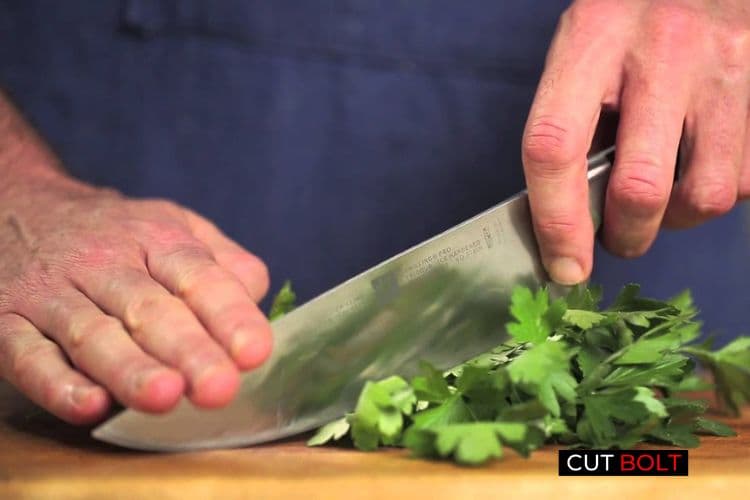
Check knives for cutting vegetables.
HOW TO CHOP WITH A CHEF KNIFE
If you cut something in half, you can get little, exact pieces by using the heel of the knife. You can cut anything from a ginger to a bone, and it looks a lot like cutting in the opposite direction.
Put your hand close to the heel and bolster, it is the thicker part of the blade. It gets more power to chop when you place your hand closer to the heel. Hold the food stable on the chopping board and press down the knife. This will give you more control for better chopping, keep chopping up and down.
HOW TO MINCE WITH A CHEF KNIFE
Mincing food is the process where you cut food into small pieces (as small as possible). The curved belly of the chef knife makes it easier to do.
Make sure the cutting board you use is big enough to accommodate the ingredients you’re mincing, and anchor the tip of your knife against the board to create a pivot point for rocking the knife back and forth.
Make sure your guiding hand is open and flat and positioned on the spine of the knife near or on the bolster. Move the knife up and down about two to three inches left to right.
Do not use the sharp edge to scrape ingredients from the cutting board. Instead, use the spine, it will save your edge from being dull.
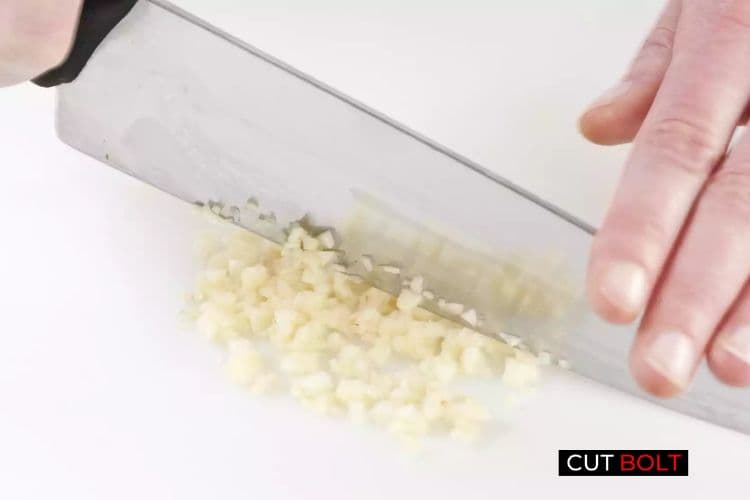
WHAT SIZE OF CHEF’S KNIFE DO YOU NEED?
There are different sizes of chef knives available. The best size of chef knife depends on your hand’s size. If you have a small to medium size hand go for a 6-8 inches long knife. If you have large hands then it will be good to go for a knife that is beyond 8 inches.
Remember 3 things while you buy a comfortable size chef knife
- It should be comfortable to hold.
- You can easily manage, maneuver the knife while cutting.
- The knife has a sharp, solid blade and good balance.
HOW TO MAINTAIN YOUR CHEF KNIFE
Use a soft cutting board like wooden or polyethylene plastic cutting boards. Using a knife on a glass or ceramic cutting board can ruin your blade. Always remember a dull knife is the most dangerous to use. You tend to put more pressure to cut through food items, the possibility of accidental cut is much higher in this process.
Wash your knife properly after using it. Avoid dishwasher washing (even if the manufacturer says it is dish-washing safe), hand wash the knife and wipe with a soft dry cloth. Let it air dry after that.
Always follow the manufacturer’s guide for sharpening the knife. They know their blades better than us.
Put your knives in a knife block. If you are storing your knives in a drawer, don’t keep them open together. Wrap them or put them in individual sheaths.
FINAL WORDS: HOW TO USE CHEF KNIFE
Hope you found the guide on using a chef knife properly helpful. One thing you need to keep in mind, always keep your cutting board secure on the table. So the board does not slide here and there on the table. Use a piece of wet cloth under your cutting board, it will fix the issue.

